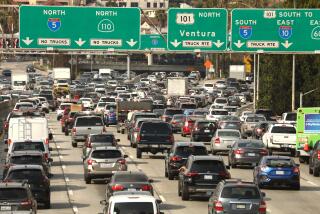Sydney’s Traffic Flows on High Tech
- Share via
SYDNEY, Australia — A lot of cities have traffic helicopters, but there are none in the world quite like the Italian-made Agusta that can be seen hovering over the winding streets of downtown Sydney.
When traffic starts backing up on any street in this sprawling metropolis, the traffic controller on board the helicopter doesn’t just report it. With the flick of a finger, the controller can change the light on any traffic signal in the city--almost before the first horn is sounded.
And if the helicopter isn’t around, any one of half a dozen engineers sitting at computer consoles in the city’s state-of-the-art traffic-control center can do the same thing, without calling a single traffic cop.
This is the Sydney Coordinated Adaptive Traffic System, and it is perhaps the most sophisticated and effective urban traffic-control network in the world.
Underground Detectors
Using cameras, underground metal detectors and the helicopter, all linked by radio to a master computer, Sydney’s traffic-control engineers can alter the city’s traffic patterns within seconds.
The only time you see traffic cops in Sydney, residents say, is when they’re writing parking tickets.
The system was designed here, entirely by Australian engineers, and its track record has been so good that it is being marketed internationally.
Singapore has bought it. So has Kuala Lumpur, Malaysia’s crowded capital city, and, most recently, the Chinese metropolis of Shanghai ordered one.
(Los Angeles has been gradually installing a similar system--without the helicopter--since shortly before the 1984 Summer Olympics. The system is already in operation in the Coliseum area and will shortly be introduced for the downtown area.
(As part of the effort to improve traffic flow, Los Angeles County officials proposed a $15-million program in late December to improve the synchronization of traffic lights on major arteries.)
High-Tech Approach
Sydney’s computerized traffic-control system is just one illustration of the quiet, high-tech revolution taking place in Australia, a country known for its laid-back approach to life and its powerful labor unions. In such a country, experts here said, it is only logical that the computer would be the hardest worker of all.
When it came to traffic, though, Sydney--Australia’s financial capital with 3.4 million people--had an additional problem.
“Here in Sydney we were very late in putting in freeways,” said John Longfoot, who heads the city’s traffic-control center. “There were no freeways at all when we began designing this system, so we had to look for the answer in our ability to control the intersections already there.”
‘Loops’ Beneath Lanes
Sydney’s scientists designed what Longfoot and his engineers call the “loop,” a tiny metal detector buried just beneath the pavement in every traffic lane at every intersection in the city. In addition, remote-controlled cameras were placed atop many downtown buildings and fixed on about 200 key intersections. The city then bought the helicopter and equipped it with computers. Finally, all this equipment was connected by radio to the city’s central traffic computer.
The process was expensive; installation cost about $40,000 per intersection, along with hardware costs of about $1 million.
“The loops tell us how many vehicles are passing through any given intersection at any given second,” Longfoot said. “If we need more information, we use the cameras or the helicopter.
“Then, if we need to alter the timing of traffic lights, we can do it all from right here in the control room or from on board the helicopter. Each intersection has a number . . . We just punch in the number and what we want done, and the computer takes care of the rest.”
More to Read
Sign up for Essential California
The most important California stories and recommendations in your inbox every morning.
You may occasionally receive promotional content from the Los Angeles Times.













